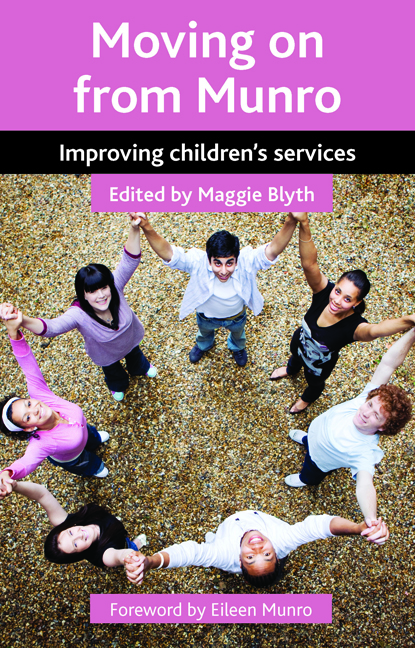Book contents
- Frontmatter
- Contents
- List of abbreviations
- Notes on contributors
- Acknowledgements
- Foreword
- Introduction
- 1 Getting the right things right
- 2 Child protection: 40 years of learning but where next?
- 3 Doing something different: reconfiguring front-line services: opening up the market
- 4 Re-imagining early help: looking forward, looking back
- 5 Children should be seen and heard: understanding the child’s experience
- 6 Responding to adolescent risk: continuing challenges
- 7 Moving on with Munro: child sexual exploitation within a child protection framework
- 8 Missing children post-Munro
- 9 Symbolic half-measures? On local safeguarding children boards, their contributions and challenges
- Conclusion
- Index
5 - Children should be seen and heard: understanding the child’s experience
Published online by Cambridge University Press: 03 February 2022
- Frontmatter
- Contents
- List of abbreviations
- Notes on contributors
- Acknowledgements
- Foreword
- Introduction
- 1 Getting the right things right
- 2 Child protection: 40 years of learning but where next?
- 3 Doing something different: reconfiguring front-line services: opening up the market
- 4 Re-imagining early help: looking forward, looking back
- 5 Children should be seen and heard: understanding the child’s experience
- 6 Responding to adolescent risk: continuing challenges
- 7 Moving on with Munro: child sexual exploitation within a child protection framework
- 8 Missing children post-Munro
- 9 Symbolic half-measures? On local safeguarding children boards, their contributions and challenges
- Conclusion
- Index
Summary
Eileen Munro's review of child protection stressed the importance of child-centred practice and framed an effective system in terms of children's right to safety (Munro, 2011, 2012). To observe the principles outlined in her final report, adult helpers need to understand and respond to each child as an individual, to work with them and to measure the effectiveness of help from the child's experience. This chapter looks at what child-centred practice might mean from a child's perspective, drawing on two recent research projects undertaken for the Office of the Children's Commissioner (OCC): children's views on ‘telling’ about abuse (Cossar et al, 2013) and a review of the impact of parental alcohol misuse (Adamson and Templeton, 2012). We did not set out to measure whether things have improved for children since the Munro review, but we believe that their perspectives will assist those asking and answering that question.
What does child-centred practice really mean?
Child-centred practice is rights-based practice. Under the United Nations Convention on the Rights of the Child (UNCRC), children have rights to protection, support and participation. These rights are interwoven and interdependent: effective protection takes account of children's own understanding of their needs, how they protect themselves, and their perception of what needs to change in their family. Conceiving protection and safety as children's basic rights can help professionals to stay focused on the child (Clifton, 2012).
Obstacles to such a focus have been identified as: helplessness or fear in the face of antagonistic parents; lack of confidence in challenging them or more influential colleagues; and lack of skills, time or knowledge of abuse or child development. The fears felt by professionals should provoke worries about the child who lives and manages such anxiety daily but they need skilled and supportive supervision to make sense of this and to learn how to develop working partnerships with parents while firmly putting the child's needs first.
Through getting to know each child well, and combining this with knowledge from research, developmental theory and professional experience, the practitioner can ‘get inside’ the child's experience.
- Type
- Chapter
- Information
- Moving on from MunroImproving Children's Services, pp. 89 - 106Publisher: Bristol University PressPrint publication year: 2014



